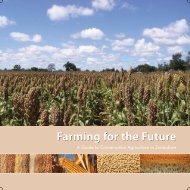Restoring the Soil - Canadian Foodgrains Bank
Restoring the Soil - Canadian Foodgrains Bank
Restoring the Soil - Canadian Foodgrains Bank
You also want an ePaper? Increase the reach of your titles
YUMPU automatically turns print PDFs into web optimized ePapers that Google loves.
62Green Manure/Cover Crop Systems<strong>the</strong> mucuna until 40 to 60 days before <strong>the</strong> maize harvest. In this way, <strong>the</strong> mucuna willkeep growing through much of <strong>the</strong> dry season, ra<strong>the</strong>r than dying in December, as itusually does. While thousands of farmers in Paraguay and Brazil use some version ofthis system, only a few hundred farmers in Guatemala and about 2,000 farmers inNicaragua do.S15. Maize/choreque. Many farmers in <strong>the</strong> west of <strong>the</strong> Department of Chimaltenangotraditionally used to intercrop choreque (Lathyrus nigrivalvis) with <strong>the</strong>ir maize (Photo33). They <strong>the</strong>n fed <strong>the</strong>ir animals on <strong>the</strong> choreque throughout <strong>the</strong> six-month dry season.The system has died out largely because <strong>the</strong> area where it was practiced has goneheavily into vegetable production, and few people have cattle any more (Photo 34).Forty years ago, slightly over 2,000 farmers used this traditional system. 17 This systemand one o<strong>the</strong>r in this section are <strong>the</strong> only ones close to dying out.S16. Coffee/tephrosia. Tephrosia vogelii has become popular in <strong>the</strong> last 35 years amonglarge-scale coffee producers on Guatemala’s south coast as a temporary shade for coffeeduring plantation establishment. Farmers plant <strong>the</strong> tephrosia at <strong>the</strong> same time as <strong>the</strong>coffee, and it shades <strong>the</strong> coffee for three to four years before <strong>the</strong> tephrosia dies out. Bythat time, <strong>the</strong> slower-growing permanent shade trees are providing adequate shade.Adopters probably number in <strong>the</strong> thousands.HondurasS17. Maize/mucuna-5. Some farmers have tried to intensify <strong>the</strong> maize/mucuna-1system by growing two crops of maize a year. This complicates management of <strong>the</strong>mucuna, but pays off in increased over-all yields per hectare. The maize is plantedin both January and May. The mucuna has mostly died out in December, but dropsseeds that will sprout in January/February. However, in April <strong>the</strong> farmers must cutdown all <strong>the</strong> mucuna or eliminate it with an herbicide. As far as we know, only a fewhundred farmers use this recently developed system.S18. Maize/mucuna-6. Around <strong>the</strong> town of Omoa on Honduras’ northwest coast,farmers have developed ano<strong>the</strong>r mucuna system. They plant maize in May/June intercroppedwith mucuna. After <strong>the</strong> harvest, <strong>the</strong>y cut down <strong>the</strong> mucuna to form a densemulch and injection plant <strong>the</strong> second crop of maize through <strong>the</strong> mulch in September,without planting mucuna. The mucuna mulch allows <strong>the</strong>m to grow <strong>the</strong> second maizecrop without ever having to weed it. Probably not more than 200 or 300 farmers usethis now traditional system (Photo 35).S19. Maize/mucuna-7. In this surprising system near La Entrada in <strong>the</strong> Department ofSanta Barbara, <strong>the</strong> mucuna is grown just as in S1, and <strong>the</strong>n is burned just before <strong>the</strong>next crop of maize is planted. Perhaps a few thousand farmers use this system.17CIDICCO, op. cit., pp. 57-61.
















